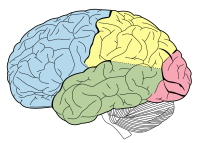
Photo from wikipedia
Brain–computer interface (BCI) technology used to monitor conscious-brain electrical activity via electroencephalogram (EEG) signals has facilitated the detection of human preferences. Recently, great progress has been made in the development… Click to show full abstract
Brain–computer interface (BCI) technology used to monitor conscious-brain electrical activity via electroencephalogram (EEG) signals has facilitated the detection of human preferences. Recently, great progress has been made in the development of novel paradigms and methods for EEG-based preference detection including attempts to apply BCI research findings in various contexts. Advances in BCI technology have increased the scientists’ interest in possible practical applications of BCI technology involving a human–machine interaction. A major objective of our research was to provide an overview of recent advances in EEG-based preference detection applications. As a foundation for our research, we reviewed previous studies in EEG-based neuromarketing and classified them according to their practical domains, research directions, and recording modalities. Another major research goal was to investigate how the analysis of EEG signals using classification algorithms can be applied to recognize and understand consumers’ mental states and preferences patterns. To this end, we built three different classification algorithms: the random forest (RF), support vector machine (SVM), and the k-nearest neighbor (KNN). Our results demonstrate that RF is more accurate than either KNN or SVM.
Journal Title: Arabian Journal for Science and Engineering
Year Published: 2021
Link to full text (if available)
Share on Social Media: Sign Up to like & get
recommendations!